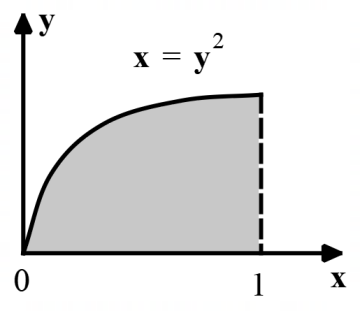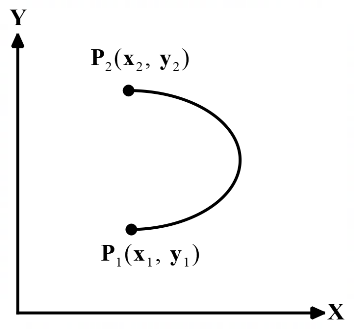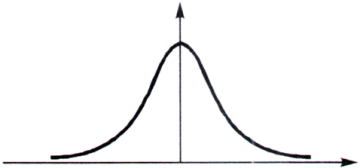31. $$\overrightarrow {\text{a}} ,\,\overrightarrow {\text{b}} ,\,\overrightarrow {\text{c}} $$ are three orthogonal vectors, Given that \[\overrightarrow {\rm{a}} = {\rm{\hat i}} + 2{\rm{\hat j}} + 5{\rm{\hat k}}\] and \[\overrightarrow {\rm{b}} = {\rm{\hat i}} + 2{\rm{\hat j}} - {\rm{\hat k}}\] , the vector $$\,\overrightarrow {\text{c}} $$ is parallel to
32. Given $$\overrightarrow {\text{F}} = \left( {{{\text{x}}^2} - 2{\text{y}}} \right)\overrightarrow {\text{i}} - 4{\text{yz}}\overrightarrow {\text{j}} + 4{\text{x}}{{\text{z}}^2}\overrightarrow {\text{k}} ,$$ the value of the line integral $$\int\limits_{\text{c}} {\overrightarrow {\text{F}} \cdot d\overrightarrow l } $$ along the straight line c from (0, 0, 0) to (1,1,1) is
33. At x = 0, the function f(x) = |x| has
34. A parabola x = y2 with 0 ≤ x ≤ 1 is shown in the figure. The volume of the solid of rotation obtained by rotating the shaded area by 360° around the x-axis is


35. The line integral $$\int\limits_{{{\text{P}}_1}}^{{{\text{P}}_2}} {\left( {{\text{ydx}} + {\text{xdy}}} \right)} $$ for P1(x1, y1) to P2(x2, y2) along the semicircle P1, P2 shown in the figure is


36. The angle between two unit-magnitude coplanar vectors P(0.866, 0.500, 0) and Q(0.259, 0.966, 0) will be
37. The following surface integral is to be evaluated over a sphere for the given steady velocity vector field F = xi + yj + zk defined with respect to a Cartesian coordinate system having i, j and k as unit base vectors.
$$\iint\limits_{\text{S}} {\frac{1}{4}\left( {{\text{F}} \cdot {\text{n}}} \right){\text{dA}}}$$ where S is the sphere, x2 + y2 + z2 = 1 and n is the outward unit normal vector to the sphere.
The value of the surface integral is
$$\iint\limits_{\text{S}} {\frac{1}{4}\left( {{\text{F}} \cdot {\text{n}}} \right){\text{dA}}}$$ where S is the sphere, x2 + y2 + z2 = 1 and n is the outward unit normal vector to the sphere.
The value of the surface integral is
38. If a function is continuous at a point,
39. The vector that is normal to the surface 2xz2 - 3xy - 4x = 7 at the point (1, -1, 2) is
40. The derivative of the symmetric function drawn in given figure will look like


Read More Section(Calculus)
Each Section contains maximum 100 MCQs question on Calculus. To get more questions visit other sections.
